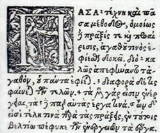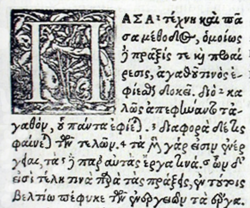
Greek ligatures
Encyclopedia

Greek alphabet
The Greek alphabet is the script that has been used to write the Greek language since at least 730 BC . The alphabet in its classical and modern form consists of 24 letters ordered in sequence from alpha to omega...
that were used in medieval handwritten Greek and in early printing. Ligatures
Ligature (typography)
In writing and typography, a ligature occurs where two or more graphemes are joined as a single glyph. Ligatures usually replace consecutive characters sharing common components and are part of a more general class of glyphs called "contextual forms", where the specific shape of a letter depends on...
were used in the cursive writing style and very extensively in later minuscule writing. There were many dozens of conventional ligatures. Some of them stood for frequent letter combinations, some for inflectional
Inflection
In grammar, inflection or inflexion is the modification of a word to express different grammatical categories such as tense, grammatical mood, grammatical voice, aspect, person, number, gender and case...
endings of words, and some were abbreviations of entire words.
In early printed Greek after c.1500, some ligatures continued to be used, although their use declined during the 17th and 18th centuries and became mostly obsolete in modern typesetting. Among the ligatures that remained in use the longest are the ligature Ȣ for ου (resembling an o with an u on top), and the abbreviation ϗ for 'and' (resembling a κ with a downward stroke on the right). Another ligature that is relatively frequent in early modern printing is a ligature of Ο with ς (a small sigma inside a capital omicron) for a terminal ος.
Stigma
The ligature for στ, now called stigmaStigma (letter)
Stigma is a ligature of the Greek letters sigma and tau , which was used in writing Greek between the middle ages and the 19th century. It is also used as a numeral symbol for the number 6...
, survived in a special role besides its original use. It took on the function of a number sign
Greek numerals
Greek numerals are a system of representing numbers using letters of the Greek alphabet. They are also known by the names Ionian numerals, Milesian numerals , Alexandrian numerals, or alphabetic numerals...
for "6", having been conflated with the ancient letter digamma
Digamma
Digamma is an archaic letter of the Greek alphabet which originally stood for the sound /w/ and later remained in use only as a numeral symbol for the number "6"...
(q.v.). In the modern computer encoding standard Unicode
Unicode
Unicode is a computing industry standard for the consistent encoding, representation and handling of text expressed in most of the world's writing systems...
, these three combinations have been given separate codepoints, since they are still occasionally used.
External links
- Renaissance Greek with Ligatures — a Greek font with hundreds of ligatures (by Vernon Kooy)

